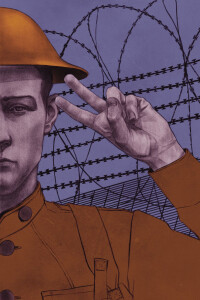 The very lightest interpretation of Dalton Trumbo’s Johnny Got His Gun is that it is an extremely dark book. With a new edition of the volume out from Suntup, it is hard not to explore the book in detail. While a famous volume, it has a contentious history, as would any anti-war book published in 1939.
The very lightest interpretation of Dalton Trumbo’s Johnny Got His Gun is that it is an extremely dark book. With a new edition of the volume out from Suntup, it is hard not to explore the book in detail. While a famous volume, it has a contentious history, as would any anti-war book published in 1939.
Johnny Got His Gun is the story of a young man, Johnny Bonham, who goes off to war and quickly finds himself experiencing one of the most horrifying worlds a human being can. He is trapped in his own mind, running through memories and thoughts as he tries to maintain sanity. It is the darkest and most difficult book about an individual’s experiences with war that many readers can name. The descriptions of sensory deprivation following severe injury manage to be simultaneously surreal and believable, horrific in so many ways.
As with any Suntup release, the additional material is one of the more interesting elements, especially the reprinted introductions and afterwords from earlier editions. The introduction by Cindy Sheehan is a heartbroken mother looking at the death of her son in a different, contentious war, and how reading this volume brought out her grief again.
Two of the reprinted introductions are by the author, one from 1959 and one from 1970. These include such details as the fact that during WWII the FBI investigated him for pulling his book and for reporting Nazi sympathizers. Given that other figures would go on to be atracked by the FBI for being “prematurely anti-Nazi,” it is a chilling reminder of evils built into governmental structures, even as the book and all of these supplements are terrifying reminders of the evil of war.
The afterword by E.L. Doctrow is a good read for anyone who enjoys that author’s writing. He discusses the status of this book as an influential anti-war piece while simultaneously noting the author’s own care in trying to prevent the book’s use by fascists as a tool to further their own goals. In addition, details of Trumbo’s life, that led to the writing of this disturbing piece, are given in excellent if brief overview.
The illustrations by Ûla Sveikauskaité are very interesting in their own light, rendered with a dark simplicity that serves to remind readers about the overall horrific and real nature of war. While not perhaps the most reflective of the contents, the image next to page 30 and its contrasted colors, had a personal appeal.
With words from the blunt to the poetically disturbing within, it is easy to recommend such a book yet simultaneously note that it is one of the hardest reads. An excellent argument should be made that everyone should read Johnny Got His Gun once, yet it is such a painful read that it is hard to get through even that. On a reread, little of the impact goes away, and for one who wants this book they will not find a better edition.
(Suntup, 2022)
